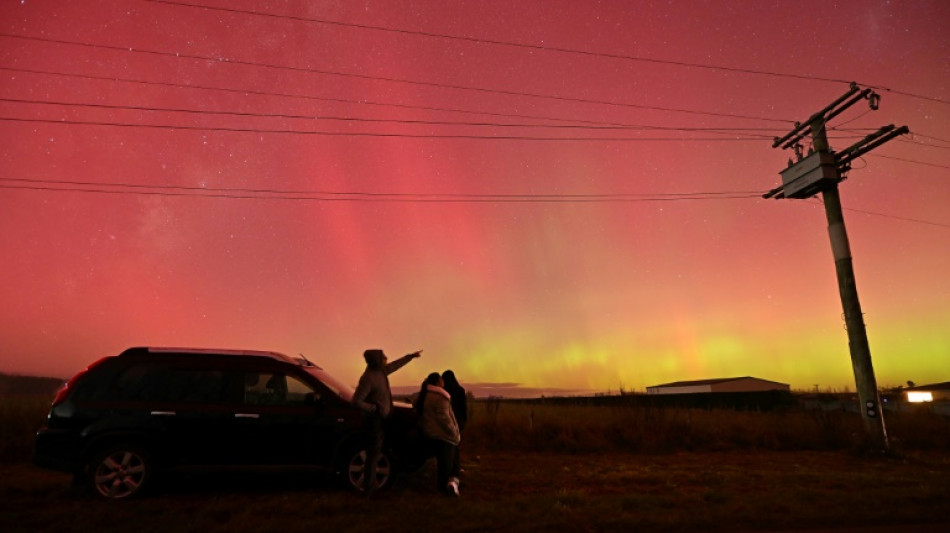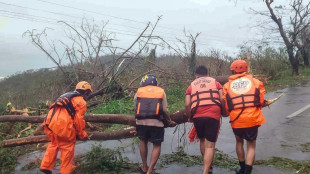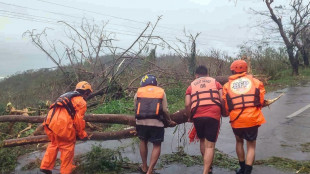
-
 Markets mixed after Wall St losses as traders weigh US rates outlook
Markets mixed after Wall St losses as traders weigh US rates outlook
-
US, Philippines sign deal on sharing military information

-
 Bangladeshi ex-ministers face 'massacre' charges in court
Bangladeshi ex-ministers face 'massacre' charges in court
-
Law and disorder as Thai police station comes under monkey attack

-
 Disgraced Singapore oil tycoon sentenced to nearly 18 years for fraud
Disgraced Singapore oil tycoon sentenced to nearly 18 years for fraud
-
Philippines cleans up as typhoon death toll rises

-
 Quincy Jones awarded posthumous Oscar
Quincy Jones awarded posthumous Oscar
-
'Critically endangered' African penguins just want peace and food

-
 Long delayed Ukrainian survival video game sequel set for release amid war
Long delayed Ukrainian survival video game sequel set for release amid war
-
Star Australian broadcaster charged with sex offences

-
 Philippines cleans up after sixth major storm in weeks
Philippines cleans up after sixth major storm in weeks
-
Woman-owned cafe in Indonesia's Sharia stronghold shakes stigma

-
 Indigenous Australian lawmaker who heckled King Charles censured
Indigenous Australian lawmaker who heckled King Charles censured
-
End of an era as Nadal aims for winning Davis Cup farewell

-
 Trump taps big tech critic Carr to lead US communications agency
Trump taps big tech critic Carr to lead US communications agency
-
Mitchell-less Cavs rip Hornets as perfect NBA start hits 15-0

-
 Markets swing after Wall St losses as traders weigh US rates outlook
Markets swing after Wall St losses as traders weigh US rates outlook
-
India's capital shuts schools because of smog

-
 Rio under high security for G20 summit
Rio under high security for G20 summit
-
G20 leaders to grapple with climate, taxes, Trump comeback

-
 Hopes set on G20 spurring deadlocked UN climate talks
Hopes set on G20 spurring deadlocked UN climate talks
-
Gabon early results show voters back new constitution

-
 Child abuse police arrest star Australian broadcaster
Child abuse police arrest star Australian broadcaster
-
Disgraced Singapore oil tycoon to be sentenced for fraud

-
 Stray dogs in Giza become tourist draw after 'pyramid puppy' sensation
Stray dogs in Giza become tourist draw after 'pyramid puppy' sensation
-
UN Security Council to weigh call for immediate Sudan ceasefire

-
 Is AI's meteoric rise beginning to slow?
Is AI's meteoric rise beginning to slow?
-
Israeli strikes on Beirut kill six, including Hezbollah official

-
 Rain wipes out England's final T20 in West Indies
Rain wipes out England's final T20 in West Indies
-
US speaker opposes calls to release ethics report on Trump's AG pick

-
 McDonald's feast undercuts Trump health pledge
McDonald's feast undercuts Trump health pledge
-
Thousands march through Athens to mark student uprising

-
 NBA fines Hornets' Ball, T-Wolves' Edwards, Bucks coach Rivers
NBA fines Hornets' Ball, T-Wolves' Edwards, Bucks coach Rivers
-
China's Xi says to 'enhance' ties with Brazil as arrives for G20: state media

-
 Bills snap nine-game Chiefs win streak to spoil perfect NFL start
Bills snap nine-game Chiefs win streak to spoil perfect NFL start
-
Biden answers missile pleas from Ukraine as clock ticks down

-
 Senegal ruling party claims 'large victory' in elections
Senegal ruling party claims 'large victory' in elections
-
Dutch plan 'nice adios' for Nadal at Davis Cup retirement party

-
 Trump meets PGA boss and Saudi PIF head amid deal talks: report
Trump meets PGA boss and Saudi PIF head amid deal talks: report
-
UN chief urges G20 'leadership' on stalled climate talks

-
 Steelers edge Ravens, Lions maul Jaguars
Steelers edge Ravens, Lions maul Jaguars
-
No.1 Korda wins LPGA Annika for seventh title of the season

-
 Biden touts climate legacy in landmark Amazon visit
Biden touts climate legacy in landmark Amazon visit
-
England secure Nations League promotion, France beat Italy

-
 Star power fails to perk up France's premiere wine auction
Star power fails to perk up France's premiere wine auction
-
Rabiot brace fires France past Italy and top of Nations League group

-
 Carsley relieved to sign off with Nations League promotion for England
Carsley relieved to sign off with Nations League promotion for England
-
Sinner says room to improve in 2025 after home ATP Finals triumph

-
 Senegal counts votes as new leaders eye parliamentary win
Senegal counts votes as new leaders eye parliamentary win
-
Biden clears Ukraine for long-range missile strikes inside Russia


Solar storms could cause more auroras
Massive explosions on the Sun have triggered warnings of geomagnetic storms that could create dazzling auroras in the northern United States, Europe and southern Australia from Tuesday night.
In May, the most powerful geomagnetic storm to strike Earth in more than two decades lit up night skies with colourful displays in Hawaii, Spain, South Africa and other places far from the extreme latitudes where they are normally seen.
"We've seen several large coronal mass ejections -- plasma and other material from the sun's surface shooting out into space," Mike Bettwy, operations chief of the US-based Space Weather Prediction Center (SWPC), told AFP on Tuesday.
"As a result, the potential for space weather has ramped up significantly," he said.
The coronal mass ejections (CMEs) are expected to arrive from Tuesday to Thursday, with "geomagnetic storm watches" declared on those days.
But "the brunt of the activity is most likely" to come on Tuesday, when there is a "strong" geomagnetic storm warning of G3 on the US National Oceanic and Atmospheric Administration scale, the SWPC said.
May's record storms were classified as the most extreme level of G5. This means any potential auroras this week are unlikely to stray as far, or be as powerful, as those seen earlier this year.
But if the current forecast is correct, during the late evening hours in the United States on Tuesday, an "aurora could become visible as far south as the northeast US through the upper Midwest and across the rest of the northern states to include northern Oregon."
The aurora borealis -- also known as the northern lights -- may become visible in Scotland over the next three nights, but could be "impeded by limited hours of darkness", the UK's Met Office said Tuesday.
"With a bit of luck," auroras could also be spotted in northern Germany, the Netherlands and Belgium, according to the website SpaceWeatherLive.
Aurora australis -- the southern lights -- could be visible in the south of the Australian state of Tasmania and similar latitudes, the Met Office said.
- 'Cannibal CME' -
For those living in the right latitudes, auroras would be most visible away from city lights, in the darkest skies possible, before the Moon rises, Bettwy said.
People should use their cameras or phones to look, because today's digital imagery can often pick them up even when the naked eye cannot, he added.
When CMEs erupt, they shoot around a billion tons of plasma -- with an accompanying magnetic field -- from the Sun toward the Earth.
One of the CMEs coming towards Earth this week merged with another, forming what is called a "Cannibal CME", according to spaceweather.com.
The NOAA warned that more CMEs are continuing to erupt, so more could be coming.
When the CMEs slam into Earth's magnetosphere, they can create geomagnetic storms.
The storms can mess with satellites orbiting Earth and affect things like radio signals and GPS positioning systems.
They can also knock out electricity grids -- the "Halloween Storms" of October 2003 sparked blackouts in Sweden and damaged power infrastructure in South Africa.
Astronauts on the International Space Station often shelter during extreme solar activity to avoid being exposed to radiation.
Numerous strong solar flares -- huge explosions on the Sun's surface which can cause CMEs -- have also been emitted in recent days.
Most CMEs and flares come from sunspots, which are massive, darker areas of intense activity on the solar surface. The sunspot cluster that caused May's storms was 17 times the size of Earth.
As of Tuesday, there are 11 sunspots on the disc of the Sun, according to the Met Office in Britain.
More geomagnetic storms could be yet to come, because solar activity is only just approaching the peak of its roughly 11-year cycle.
The peak, called "solar maximum", is expected between late 2024 and early 2026.
A.Williams--AT

